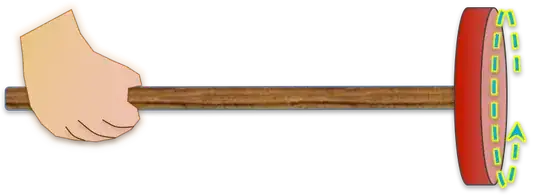Context
I'm a psychologist and I'm interested in perception of gyroscopic forces. For that reason, I'm having to think about many of the classic issues relating to gyroscopes in reverse. That is, instead of predicting what imposed forces will do to a gyroscope assembly, I must think in terms what forces will be imposed by the assembly on a perceiver, in order to make predictions about how it will be perceived.
System
Imagine a gyroscope mounted on a rod, such that the rod could be wielded by someone. Held perfectly level, there would be no precession forces because the person's hand is applying a torque that counteracts gravity. Thus, the direction of angular momentum is not changed.
Now imagine the wielder rotates his wrist 90 degrees in a forehand direction. This applies a torque about the axis of the wrist, sweeping the rod away from our view as shown in the figure. This reorients the gyroscope by 90 degrees as well, and the angular momentum causes the end of the rod to "lift" somewhat during this rotation, because it is in the direction of precession. That is, less torque is required by the wielder to counteract gravity during this rotation when the gyroscope is spinning, than if it were not spinning.
Question
How do I characterize this apparent "lifting" force mathematically? (Is "force" even the right way to describe it?) That is, if I have a flywheel of a known mass and radius, spinning at a known rate, how do I calculate the force that it will apply to the palm of the person wielding it on a rod of known length, through a 90 degree rotation?
